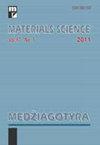Influence of Heat Input on Microstructure and Mechanical Properties of Laser Weld Metal in 2507 Duplex Stainless Steel by Different Welding Speed and Welding Power
IF 0.6
4区 材料科学
Q4 MATERIALS SCIENCE, MULTIDISCIPLINARY
引用次数: 0
Abstract
This manuscript attempts to explore the macroscopic morphology microstructural aspects and mechanical properties of different laser welding speed and power on the 2.5 mm thick DSS welding joint. Through the evaluation of 12 groups samples with different welding parameters, we found that the optimal laser welding process parameters were a welding speed of 6mm/s, laser power of 1.6 kW and welding speed of 8 mm/s, laser power of 1.7 kW. When the heat input was 2.125 kJ/cm, the content of ferrite and austenite was relatively uniform, and the ratio was close to 1:1. We found that the hardness of the weld metal zone was slightly higher than that of the base metal, with an average value of 330 HV. When the heat input was 2.125 kJ/cm, the microhardness of welded joint was better than other parameters, reaching 400 HV in the welding metal zone. The tensile strength of the weld was enhanced with the increase of heat input, and the maximum was 900 MPa. Through SEM analysis, the fracture locations of tensile specimens were all in the weld zone, and the fracture morphology had a large number of dimples, belonging to the ductile fracture.不同焊接速度和焊接功率对2507双相不锈钢激光焊接金属组织和力学性能的影响
本文试图探讨不同激光焊接速度和功率对2.5 mm厚DSS焊接接头的宏观形貌、微观组织和力学性能的影响。通过对12组不同焊接参数的样品进行评价,我们发现最佳的激光焊接工艺参数为焊接速度为6mm/s,激光功率为1.6 kW,焊接速度为8 mm/s,激光功率为1.7 kW。当热输入为2.125 kJ/cm时,铁素体和奥氏体的含量相对均匀,比例接近1:1。我们发现焊缝金属区的硬度略高于母材,平均值为330 HV。当热输入为2.125 kJ/cm时,焊接接头的显微硬度较好,焊接金属区达到400 HV。焊缝的抗拉强度随热输入的增加而提高,最大可达900 MPa。通过SEM分析,拉伸试样的断裂位置均在焊缝区,断口形貌上有大量韧窝,属于韧性断裂。
本文章由计算机程序翻译,如有差异,请以英文原文为准。
求助全文
约1分钟内获得全文
求助全文
来源期刊

Materials Science-medziagotyra
工程技术-材料科学:综合
CiteScore
1.70
自引率
10.00%
发文量
92
审稿时长
6-12 weeks
期刊介绍:
It covers the fields of materials science concerning with the traditional engineering materials as well as advanced materials and technologies aiming at the implementation and industry applications. The variety of materials under consideration, contributes to the cooperation of scientists working in applied physics, chemistry, materials science and different fields of engineering.
 求助内容:
求助内容: 应助结果提醒方式:
应助结果提醒方式:


